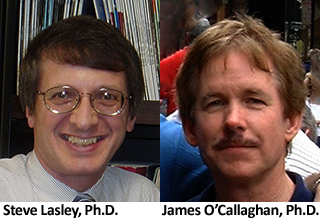


Posted November 10, 2014
Steve Lasley, Ph.D., University of Illinois College of Medicine at Peoria
James O'Callaghan, Ph.D., Centers for Disease Control and Prevention - National Institute for Occupational Safety and Health
 Gulf War Illness (GWI) is a multi-symptom disorder with features characteristic of "sickness" behavior including cognitive impairment, fatigue, depression, sleep disruption, muscle and joint pain, and gastrointestinal and dermatological problems.
Gulf War Illness (GWI) is a multi-symptom disorder with features characteristic of "sickness" behavior including cognitive impairment, fatigue, depression, sleep disruption, muscle and joint pain, and gastrointestinal and dermatological problems.
Typically, sickness behavior is the normal manifestation of an inflammatory response to infection or injury and one that resolves with restoration of homeostasis. In GWI such symptoms persist, and research suggests this may be due to heightened and chronic inflammation of the nervous system following a mild toxic exposure to any of a number of neurotoxic compounds.
In work supported by a Fiscal Year 2008 Gulf War Illness Research Program (GWIRP) Investigator-Initiated Research Award, Dr. Steve Lasley at the University of Illinois College of Medicine at Peoria, along with collaborator Dr. James O'Callaghan at the Centers for Disease Control and Prevention - National Institute for Occupational Safety and Health, set out to characterize chronic neuroinflammation using an animal model of GWI. To produce the initial elevated level of inflammation in mice, Drs. Lasley and O'Callaghan and their teams gave animals low doses of an acetylcholinesterase inhibitor called diisopropyl fluorophosphate (DFP). In these experiments this chemical was used as a nerve gas surrogate: At higher doses it can cause neuronal damage by abolishing the normal signal transmission at connections involving one type of nerves. This results in excess nerve firing, possibly leading to seizures and nerve system damage due to overstimulation.
Using this procedure, the researchers found that exposure to a single dose of DFP that did not produce overt signs of toxicity in the animals did result in inflammation in the brain, which was measured by monitoring inflammatory cytokine levels and microglial activation. Furthermore, the observed neuroinflammatory response was exacerbated when animals were given the stress hormone corticosterone (CORT) prior to DFP exposure. This was an unexpected finding because CORT is generally thought to be an immunosuppressive hormone secreted by the body to prevent damage from the body's own inflammatory responses. Instead of reducing the initial neuroinflammatory response to DFP, prior exposure to CORT was found to "prime" the immune system of DFP-treated animals to mount an exaggerated response. This phenomenon could also be produced after brief CORT exposure using another inflammogen called lipopolysaccharide. Giving mice occasional doses of CORT over time (as a person might naturally experience in a war theater as a result of day-to-day stresses) was found to maintain this pro-inflammatory state for 180 days, which is the approximate human equivalent of 20 years.
Dr. O'Callaghan further discovered that the tetracycline-like antibiotic minocycline was able to reduce both DFP-induced and CORT-enhanced neuroinflammation. Minocycline is a U.S. Food and Drug Administration-approved antibiotic that is known to exert immune suppressive, anti-inflammatory effects in addition to its antibiotic properties. Furthermore, minocycline is also known to cross the blood-brain barrier, allowing it to suppress inflammation in the brain. These characteristics, along with the findings by Dr. O'Callaghan, suggest that minocycline may be an effective treatment option for veterans suffering from GWI. The GWIRP is supporting continuation of research on the immune system priming by CORT and possible treatments using minocycline through Gulf War Illness Consortium grants to Boston and Nova Southeastern Universities, which are expected to conduct human treatment trials.
Links:














